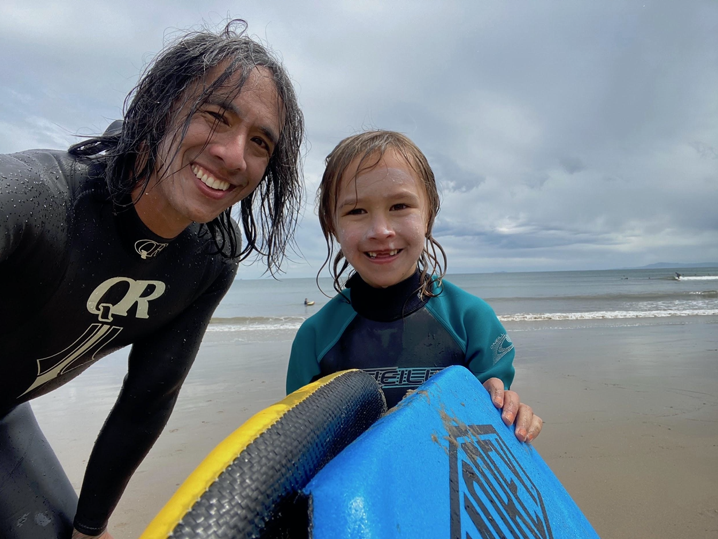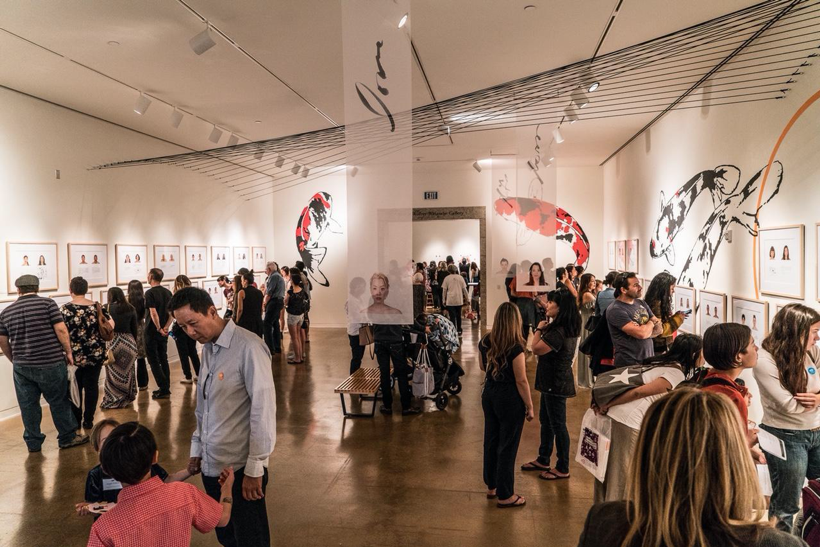By Alexandra Lee
Even with much on hiatus during the coronavirus pandemic, the UC Santa Barbara community continues to put a priority on promoting diversity, equality and social justice. In Humanities and Fine Arts, the Academic Senate has recognized Art professor Kip Fulbeck’s many achievements with the 2019-2020 Faculty Diversity Award.
Fulbeck is renowned for his groundbreaking exhibition and book “The Hapa Project,” which ran for 15 years and featured raw portraits of multiethnic individuals and their personal stories about being mixed-race. The term “hapa” is typically used to identify people of partially Asian or Pacific Islander descent.
Artist and UCSB professor Kip Fulbeck enjoying a day at the beach with his son. Photo by Kip Fulbeck.
Fulbeck also incorporates identity politics into his teachings, working towards an equality-focused vision of academic freedom. He began teaching at UCSB in 1992 as a lecturer in Asian American Studies, and has since become an influential voice not only among his own art students, but by speaking up for underrepresented students.
Fulbeck recently spoke to HFA in an interview about breaking barriers in both his art projects and teaching.
Q: How do you focus on diversity and social justice, both in your teaching at UCSB and in your work?
A: I don’t think I really do. I just teach. I don't specifically try to address that. It’s just sort of the way we have to be. My work has always been based around identity and defining who we are, and I give people pathways through which to do that, making sure that various points of view are being heard and respected, and that includes points of view that I may not agree with. My main thing is exposing students the best I can to a myriad of ideas that are often very intellectually and politically challenging for them, and sometimes they are offensive.
Q: How do you encourage your students to expand their own self-identity?
A: Oftentimes we think that we have no story to tell because we’ve been programmed that the only stories that are viable are ones that are made into web series or movies or bestselling novels. But I think that any student coming in is going to be 17 years old with 17 years of history—of family history, education, sex, friendship, all these different things that have informed them over these thousands and thousands of days, and every one of those can be tapped into to create meaning from.
Q: How did working on The Hapa Project change your outlook on life?
A: Many people had said ‘I’d been waiting so long to do this,’ that it’s interesting because the project was really a very simple idea. It’s just ‘take a picture and story,’ but people really wanted to do it and they wanted to do it with me shooting them. Even though it’s like 30 seconds, you could do it yourself. But people said ‘No, I want to do it the way it’s been done,’ and that was really humbling. I always felt like a charlatan because 90% of the work is people. It’s your story, and it’s your thing that’s so entertaining. I just created a simple format.
Opening day of Kip Fulbeck’s exhibit, “hapa.me - 15 years of the hapa project,” at the Japanese American National Museum in Los Angeles, in April 2018. Photo by Kip Fulbeck.
Q: You said in an interview over ten years ago that both art and teaching as professions lack the respect and value that they deserve. Do you still feel the same way about that, or how has that changed?
A: You look at these cradles of civilization that we talk about, like Mesopotamia or the Renaissance or Ancient Greece. We remember the creative works. You remember Homer, you remember Michelangelo, you remember these creative works of plays and music and philosophy, and it’s all that ancient Greece stuff that’s coming out. And now as we’ve focused more and more and more on STEM, which there’s nothing wrong about, and it’s certainly vastly needed, we’ve lost the thread of how important the humanities and fine arts are to us as people.
Alexandra Lee is a second-year Communication and Global Studies double major at UC Santa Barbara. She wrote this article for her Writing Program class, Journalism for Web and Social Media.



